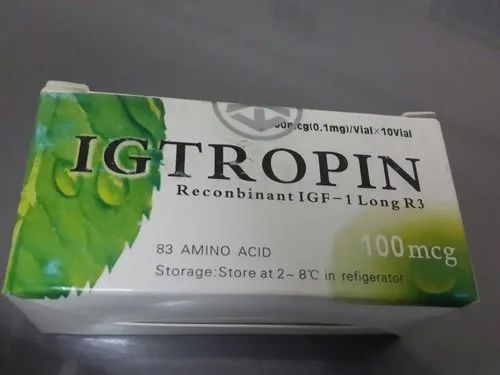What Is Tesamorelin?
Tesamorelin is a synthetic peptide used in medicine for a specific purpose. It is classified as a growth hormone-releasing hormone (GHRH) analog and is primarily used to stimulate the production and release of growth hormone (GH) from the pituitary gland. This hormone is crucial in various physiological processes, including growth, metabolism, and tissue repair.
This peptide is often prescribed to individuals with HIV-associated lipodystrophy. It helps reduce excess abdominal fat, improving body composition and potentially enhancing insulin sensitivity.
Tesamorelin Structure
- Sequence (Single Letter): Unk-Tyr-Ala-Asp-Ala-Ile-Phe-Thr-Asn-Ser-Tyr-Arg-Lys-Val-Leu-Gly-Gln-Leu-Ser-Ala-Arg-Lys-Leu-Leu-Gln-Asp-Ile-Met-Ser-Arg-Gln-Gln-Gly-Glu-Ser-Asn-Gln-Glu-Arg-Gly-Ala-Arg-Ala-Arg-Leu. HGH FRAGMENT
- Molecular Formula: C223H370N72O69S
- Molecular Weight: 5195.908 g/mol
- PubChem CID: 44147413
- CAS Number: 901758-09-6
Tesamorelin and Lypodystrophy
Tesamorelin is a synthetic growth hormone-releasing factor that has shown promise in the treatment of lipodystrophy, particularly in patients with HIV-associated lipodystrophy. Lipodystrophy refers to changes in body fat distribution and metabolism that can occur as a side effect of antiretroviral therapy for HIV.
Several studies have demonstrated the efficacy of tesamorelin in reducing central fat accumulation and improving visceral adiposity in patients with HIV-associated lipodystrophy. Clinical trials have shown that tesamorelin injections can significantly decrease visceral abdominal fat and improve body image.
Furthermore, tesamorelin has been found to have minimal effects on CYP3A, an enzyme involved in drug metabolism. This suggests that tesamorelin may not interfere with or be affected by medications metabolized by CYP3A.
The U.S. Food and Drug Administration (FDA) has approved tesamorelin for the treatment of lipodystrophy in patients with HIV. This approval was based on the positive results from clinical trials showcasing the effectiveness of tesamorelin in reducing visceral fat and improving lipid profiles.
Tesamorelin Investigated in Cardiac Disease
While tesamorelin has primarily been studied in treating lipodystrophy, there are also investigations into its potential effects on cardiac disease. However, it is important to note that long-term cardiovascular benefits have not been extensively studied.
One study found that lower visceral adipose tissue (VAT) and subcutaneous adipose tissue (SAT) density, which can be improved by tesamorelin, were associated with lower levels of adiponectin (a protein involved in regulating glucose and fatty acid metabolism) and increased cardiovascular disease risk.
Additionally, another research suggested that tesamorelin may have a modest beneficial effect on adiponectin and fibrinolytic markers in HIV patients with abdominal adiposity. It is worth mentioning that the safety pharmacology studies for tesamorelin have explored its potential effects on the cardiovascular system, among other systems.
Growth Hormone Deficiency and HIV
Growth hormone deficiency (GHD) can be a common complication in individuals with HIV infection. HIV-associated lipodystrophy often includes GHD as one of its components.
In patients with HIV-associated lipodystrophy and GHD, growth hormone replacement therapy (GHRT) has shown promising results in improving body composition and metabolic parameters. GHRT can help increase lean body mass, decrease fat mass, and improve lipid profiles. It has also been associated with improvements in bone mineral density and quality of life.
However, it’s important to note that the use of GHRT in HIV patients should be carefully evaluated and monitored, as there may be potential interactions with antiretroviral medications and other comorbidities.
Growth hormone deficiency is a significant concern in individuals with HIV, and growth hormone replacement therapy can be considered as a potential treatment option to address the associated metabolic and body composition changes.
Tesamorelin for Peripheral Nerve Damage
Tesamorelin has been investigated for its potential use in peripheral nerve damage. Several studies and clinical trials have assessed its efficacy in enhancing axonal regeneration and improving functional outcomes following peripheral nerve injuries.
These studies suggest that GH-based therapies, such as tesamorelin, hold promise in the treatment of peripheral nerve injuries due to their multi-modal mechanism of action.
Tesamorelin Investigated in Dementia
Exciting new evidence has emerged regarding the potential benefits of GHRH analogues, including tesamorelin, in enhancing cognition among individuals in the early stages of dementia. A groundbreaking study conducted at the University of Washington School of Medicine shed light on the positive influence of tesamorelin and similar analogues on dementia by modulating specific brain chemicals.
In this comprehensive twenty-week-long study, researchers employed a rigorous methodology with randomized, double-blind, placebo-controlled design. The results pointed towards the intriguing role of tesamorelin in increasing levels of gamma-aminobutyric acid (GABA) while simultaneously lowering (MI) myo-inositol levels in the brain.
Please note that all the articles and product information provided on this website are intended for informational and educational purposes only.
The products offered on this platform are specifically designed for in-vitro studies, meaning they are conducted outside the body.





Reviews
There are no reviews yet.